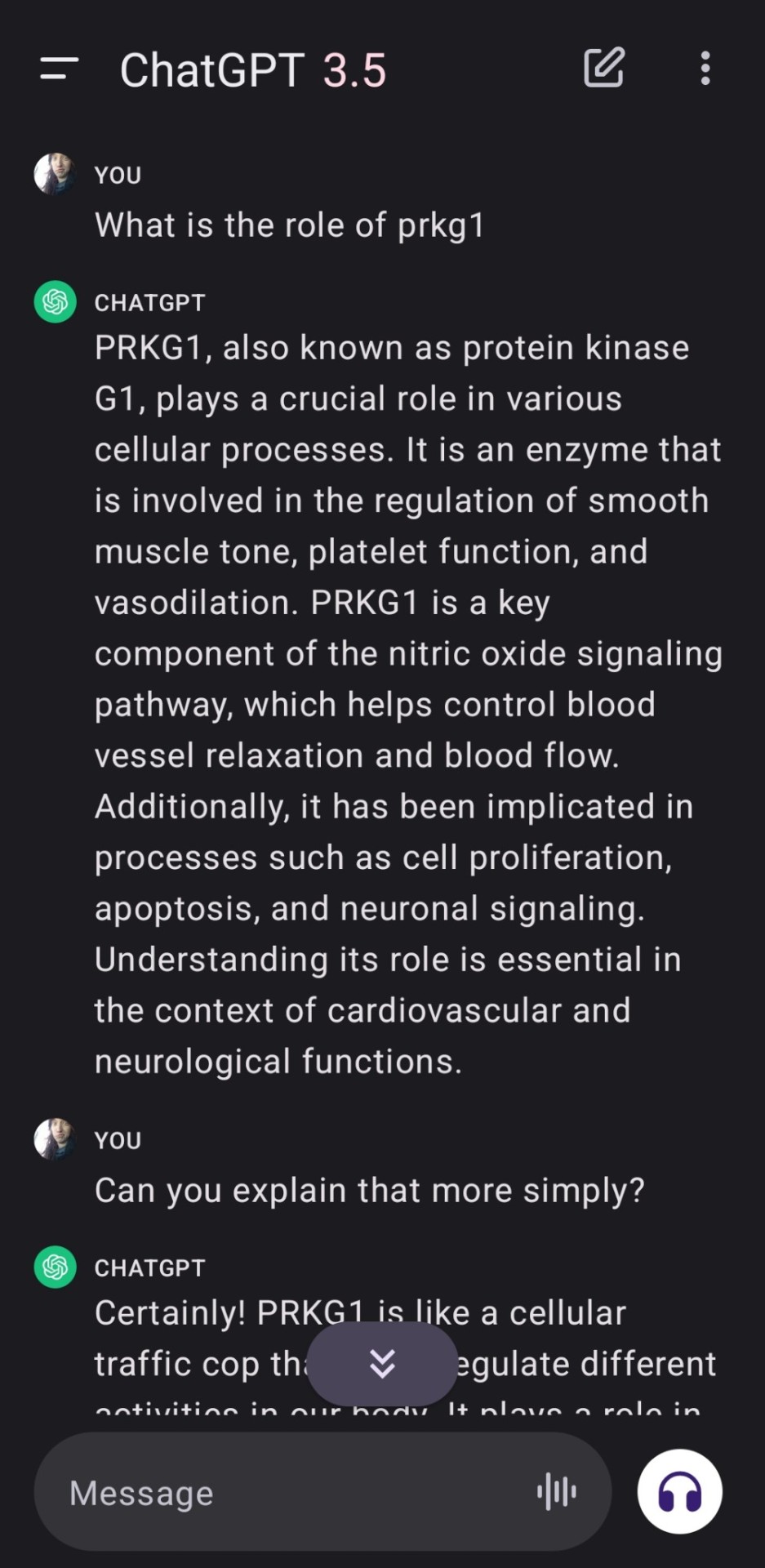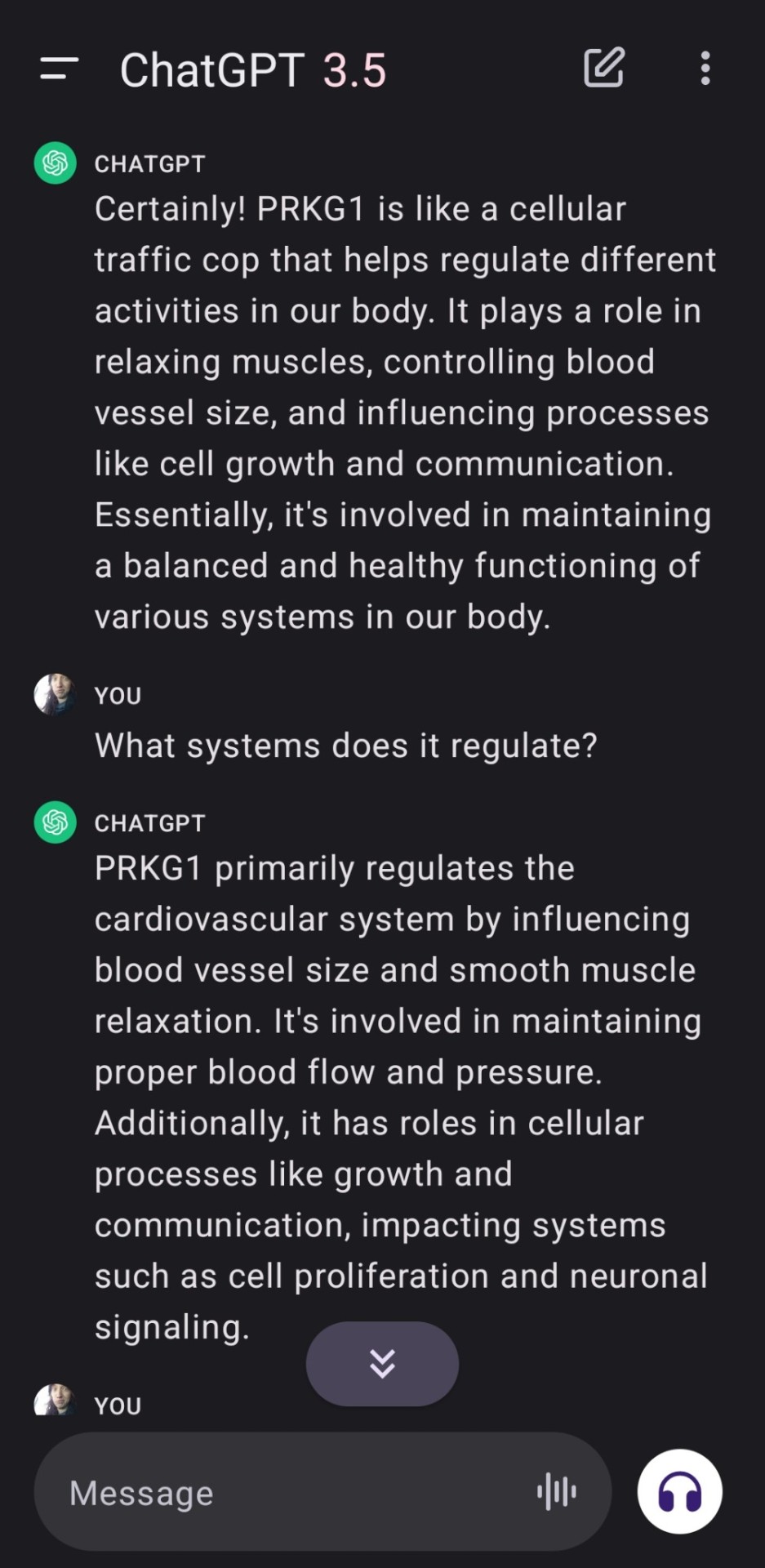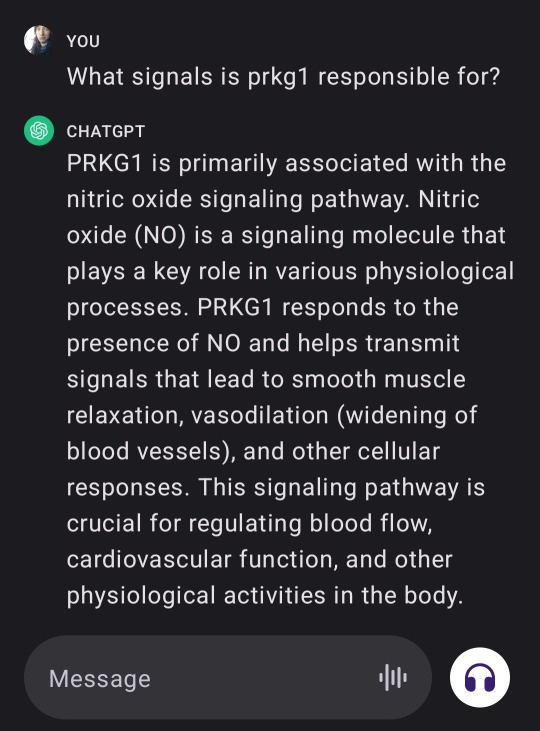#prkg1
Text
What's wrong with you?
Well, I asked chat gpt to explain it like I'm a child. Feels like a glitch in the matrix. Glad I finally have a science based explanation.
In short. The code sometimes doesn't transfer all needed material so I glitch a little.
Come along while I gain the courage to share my journey.










#dysautonomia#wegotdys#pots#autonomic dysfunction#chronic illness#chronic pain#chronically ill#chronic fatigue#mcas#its complicated#prkg1#genetics#genetic disorders
8 notes
·
View notes
Link
Potential Autoimmunity Resulting from Molecular Mimicry between SARS-CoV-2 Spike and Human Proteins
Abstract
Molecular mimicry between viral antigens and host proteins can produce cross-reacting antibodies leading to autoimmunity. The coronavirus SARS-CoV-2 causes COVID-19, a disease curiously resulting in varied symptoms and outcomes, ranging from asymptomatic to fatal. Autoimmunity due to cross-reacting antibodies resulting from molecular mimicry between viral antigens and host proteins may provide an explanation. Thus, we computationally investigated molecular mimicry between SARS-CoV-2 Spike and known epitopes. We discovered molecular mimicry hotspots in Spike and highlight two examples with tentative high autoimmune potential and implications for understanding COVID-19 complications. We show that a TQLPP motif in Spike and thrombopoietin shares similar antibody binding properties. Antibodies cross-reacting with thrombopoietin may induce thrombocytopenia, a condition observed in COVID-19 patients. Another motif, ELDKY, is shared in multiple human proteins, such as PRKG1 involved in platelet activation and calcium regulation, and tropomyosin, which is linked to cardiac disease. Antibodies cross-reacting with PRKG1 and tropomyosin may cause known COVID-19 complications such as blood-clotting disorders and cardiac disease, respectively. Our findings illuminate COVID-19 pathogenesis and highlight the importance of considering autoimmune potential when developing therapeutic interventions to reduce adverse reactions.
#molecular mimicry#covid-19#covid-19 vaccine#sars-cov-2#spike protein#biological WMD#print this off later
4 notes
·
View notes
Quote
Recent studies have shown that the hypothalamus functions as a control center of aging in mammals that counteracts age-associated physiological decline through inter-tissue communications. We have identified a key neuronal subpopulation in the dorsomedial hypothalamus (DMH), marked by Ppp1r17 expression (DMHPpp1r17 neurons), that regulates aging and longevity in mice. DMHPpp1r17 neurons regulate physical activity and WAT function, including the secretion of extracellular nicotinamide phosphoribosyltransferase (eNAMPT), through sympathetic nervous stimulation. Within DMHPpp1r17 neurons, the phosphorylation and subsequent nuclear-cytoplasmic translocation of Ppp1r17, regulated by cGMP-dependent protein kinase G (PKG; Prkg1), affect gene expression regulating synaptic function, causing synaptic transmission dysfunction and impaired WAT function. Both DMH-specific Prkg1 knockdown, which suppresses age-associated Ppp1r17 translocation, and the chemogenetic activation of DMHPpp1r17 neurons significantly ameliorate age-associated dysfunction in WAT, increase physical activity, and extend lifespan. Thus, these findings clearly demonstrate the importance of the inter-tissue communication between the hypothalamus and WAT in mammalian aging and longevity control.
DMHPpp1r17 neurons regulate aging and lifespan in mice through hypothalamic-adipose inter-tissue communication - ScienceDirect
0 notes
Text
Epigenetic and #miRNA expression changes in people with pain: a systematic review.
Related Articles
Epigenetic and #miRNA expression changes in people with pain: a systematic review.
J Pain. 2019 Dec 11;:
Authors: Polli A, Godderis L, Ghosh M, Ickmans K, Nijs J
Abstract
Accumulating evidence suggests that epigenetic mechanisms may hold great potential in the field of pain. We systematically reviewed the literature exploring epigenetic mechanisms in people with pain. Four databases have been interrogated: MEDLINE, The Cochrane Central Register of Controlled Trial, Scopus, and Web of Science, following PRISMA guidelines in conducting study selection and assessment. Thirty-seven studies were included. Studies explored epigenetics in conditions such as fibromyalgia, CRPS, neuropathies, or osteoarthritis. Research focussed on genome-wide and gene-specific DNA methylation, and #miRNA expression. Bioinformatics analyses exploring #miRNA-associated molecular pathways were also performed. Several genes already known for their role in pain (BDNF, HDAC4, PRKG1, IL-17, TNFRSF13B, etc.), and several #miRNAs linked to inflammatory regulation, nociceptive signalling and protein kinases functions have been found to differ significantly between people with chronic pain and healthy controls. Although the studies included were cross-sectional in nature, and no conclusion on causal links between epigenetic changes and pain could be drawn, we summarised the large amount of data available in literature on the topic, highlighting results that have been replicated by independent investigations. The field of pain epigenetics appears very exciting and has all the potential to lead to remarkable scientific advances. However, high-quality, well-powered, longitudinal studies are warranted. Perspective: Though more high-quality research is needed, available research exploring epigenetic mechanisms or #miRNAs in people with pain shows that genes regulating synaptic plasticity and excitability, protein kinases, and elements of the immune system might hold great potential in understanding the pathophysiology of different conditions.
PMID: 31837447 [PubMed - as supplied by publisher] http://bit.ly/36GSalL
0 notes
Photo

Аналог гена дрозофил поделил людей на «кочевников» и «оседлых».
Ген for (от англ. forage — фураж, или корм) встречается не только у мух, но также у пчел и круглых червей. От того, какой вариант гена достался животному, зависит предпочитаемая им стратегия поведения при поиске пищи. Фуражиры-«кочевники» (rovers) активно патрулируют пространство в поисках пищи, в то время как «оседлые» (sitters) остаются в безопасном месте до тех пор, пока не заметят гарантированную добычу. Даже сутки, проведенные без еды, не делают «оседлых» более рискованными: их подвижность при этом едва достигает нижней границы активности «кочевников».
В геноме человека есть ортолог for — то есть ген, имеющий с ним общего предка — это PRKG1. Он кодирует белок, который находят по всей нервной системе человека и связывают с нейропластичностью и обучением. Кроме того, среди людей встречаются и типы поведения при поиске пищи, чем-то напоминающие патрули «кочевников» и терпеливое ожидание «оседлых». Социальная психология называет их «двигателями» (locomotors) и «оценщиками» (assessors). Однако никто раньше не проверял, связана ли поисковая стратегия индивида с вариацией гена PRKG1.
Группа ученых из США, Англии и Канады провела два эксперимента. Для первого из них они воспользовались данными консорциума CommonMind: полными геномами 153 человек и результатами их психологических опросников. Исследователи оценили испытуемых по шкале «двигатель-оценщик» и сопоставили результаты с последовательностью их гена PRKG1. В этом гене ученым удалось обнаружить два распространенных однонуклеотидных полиморфизма: А и С, а у испытуемых — три варианта сочетаний: АА, СА и СС. При этом все люди с генотипом АА оказались «оценщиками», а СА — «двигателями», а среди СС встречались и те, и другие.
Однако выборка получилась не вполне достоверной, так как больше половины в ней составляли женщины, а людей с генотипом СС оказалось всего 12%. Поэтому эксперимент повторили уже с 437 студентами Университета Ватерлоо в Канаде. Среди них, правда, тоже нашлось мало носителей СС, зато количество мужчин и женщин было примерно равным. У них студентов собрали генетический материал, а затем предложили пройти поведенческий тест. Нужно было, нажимая на экран планшета, «кормиться» ягодами разного размера, которые на нем появлялись. При этом исследователи фиксировали не только количество собранных ягод, но также траекторию движения руки над экраном.
Студенты разделились на три группы. Стратегия первой очень напоминала «оседлых» мух: они двигались в основном вдоль «безопасных» границ экрана и собирали ягоды в ближайшей их окрестности. Они реагировали в том числе на маленькие ягоды и продолжали собирать их в «домашнем» регионе, даже когда в нем ягод оставалось немного. Так чаще вели себя носители генотипа АА и некоторые носители СА, и очень редко — носители СС.
Вторая группа была чем-то похожа на мух-«кочевников»: испытуемые хаотически перемещали руку над экраном, пытаясь охватить все доступное им пространство.
Третьи же продемонстрировали новую стратегию, не освоенную мухами, — систематическую зачистку поля от ягод, двигаясь «змейкой» поперек экрана: по горизонтали от края до края, затем сдвиг выше, и снова движение поперек, в обратную сторону. Эффективность сбора оказалась примерно одинаковой у всех трех групп.
Однозначно установить связь «кочевого» и «систематичного» сбора ягод с генотипом не удалось, но про «оседлый» авторы уверенно заключают, что он связан с полиморфизмом А в гене PRKG1. Это в некотором роде объединяет нас с дрозофилами и позволяет надеяться, что и для других особенностей человеческого поведения удастся найти ключевые гены и аналоги у животных.
http://bit.ly/2SLLgsM
0 notes
Text
Combining landscape genomics and ecological modelling to investigate local adaptation of indigenous Ugandan cattle to East Coast fever
East Coast fever (ECF) is a fatal sickness affecting cattle populations of eastern, central, and southern Africa. The disease is transmitted by the tick Rhipicephalus appendiculatus, and caused by the protozoan Theileria parva parva, which invades host lymphocytes and promotes their clonal expansion. Importantly, indigenous cattle show tolerance to infection in ECF-endemically stable areas. Here, the putative genetic bases underlying ECF-tolerance were investigated using molecular data and epidemiological information from 823 indigenous cattle from Uganda. Vector distribution and host infection risk were estimated over the study area and subsequently tested as triggers of local adaptation by means of landscape genomics analysis. We identified 41 and seven candidate adaptive loci for tick resistance and infection tolerance, respectively. Among the genes associated with the candidate adaptive loci are PRKG1 and SLA2. PRKG1 was already described as associated with tick resistance in indigenous South African cattle, due to its role into inflammatory response. SLA2 is part of the regulatory pathways involved into lymphocytes' proliferation. Additionally, local ancestry analysis suggested the zebuine origin of the genomic region candidate for tick resistance. http://dlvr.it/QRw5cH
0 notes
Text
What's wrong with you?
Well, I asked chat gpt to explain it like I'm a child. Feels like a glitch in the matrix. Glad I finally have a science based explanation.
In short. The code sometimes doesn't transfer all needed material so I glitch a little.
Come along while I gain the courage to share my journey.










#dysautonomia#wegotdys#pots#autonomic dysfunction#chronic illness#chronic pain#chronically ill#chronic fatigue#mcas#its complicated#prkg1#genetics#genetic disorders
1 note
·
View note